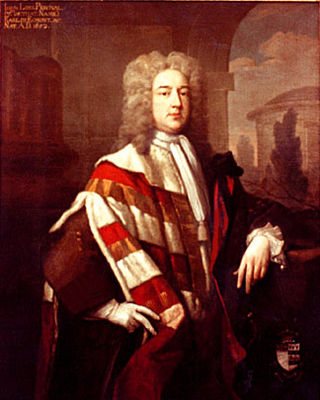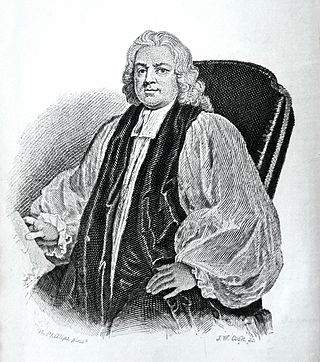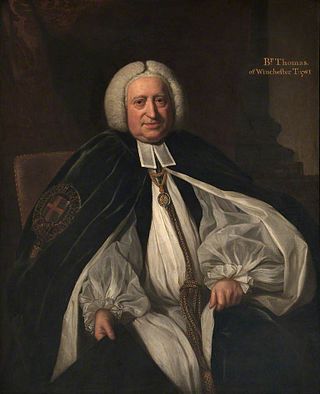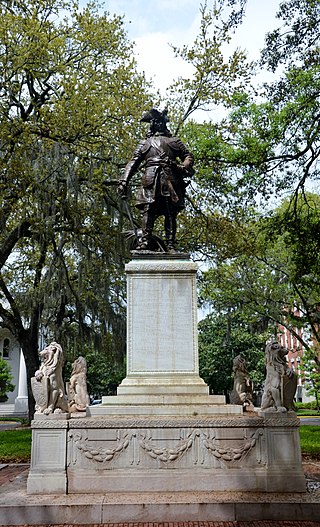Related Research Articles

Thomas Secker was an Archbishop of Canterbury in the Church of England.

The Province of Georgia was one of the Southern Colonies in colonial-era British America. In 1775 it was the last of the Thirteen Colonies to support the American Revolution.

Thomas Bray was an English clergyman and abolitionist who helped formally establish the Church of England in Maryland, as well as the Society for the Propagation of Christian Knowledge and Society for the Propagation of the Gospel in Foreign Parts.

John Perceval, 1st Earl of Egmont, PC, FRS, known as Sir John Perceval, Bt, from 1691 to 1715, as The Lord Perceval from 1715 to 1722 and as The Viscount Perceval from 1722 to 1733, was an Anglo-Irish politician.

Thomas Wilson was Bishop of Sodor and Man between 1697 and 1755.
Anthony Ashley Cooper, 4th Earl of Shaftesbury Bt PC FRS was a British peer and philanthropist, who was one of the leading figures in the foundation of the colony of Georgia and served as Lord Lieutenant of Dorset from 1734 until his death.
Samuel Nunes (1668–1744) was a Portuguese physician and among the earliest Jews to settle in North America.

John Thomas was an English bishop.
Walter Haddon LL.D. (1515–1572) was an English civil lawyer, much involved in church and university affairs under Edward VI, Queen Mary, and Elizabeth I. He was a University of Cambridge humanist and reformer, and was highly reputed in his time as a Latinist. He sat as an MP during the reigns of Mary and Elizabeth. His controversial exchange with the Portuguese historian Jerónimo Osório attracted international attention partly on account of the scholarly reputations of the protagonists.
John Newte (1656–1716) was a high Anglican clergyman best remembered as the defender of the lawfulness of church music.
Trustee Georgia is the name of the period covering the first twenty years of Georgia history, from 1732–1752, because during that time the English Province of Georgia was governed by a board of trustees. England's King George II, for whom the colony was named, signed a charter establishing the colony and creating its governing board on July 7, 1732. His action culminated a lengthy process. Tomochichi was a Native American that resides along the Savannah River that allowed Oglethorpe to settle on the Yamacraw Bluff.
William Stephens, of Bowcombe, near Newport, Isle of Wight, and later Beaulieu, Savannah, Georgia, was an English Tory politician who sat in the House of Commons from 1702 to 1727. He emigrated to Georgia and was governor of the Province of Georgia between 1743 and 1751.
The Trustees for the Establishment of the Colony of Georgia in America, or simply the Georgia Trustees, was a body organized by James Edward Oglethorpe and associates following parliamentary investigations into prison conditions in Britain. After being granted a royal charter in 1732, Oglethorpe led the first group of colonists to the new colony, arriving there in February, 1733. The trustees governed Georgia, one of the Thirteen Colonies, from its founding until 1752, a period known as Trustee Georgia.

John Pine (1690–1756) was an English designer, engraver, and cartographer notable for his artistic contribution to the Augustan style and Newtonian scientific paradigm that flourished during the British Enlightenment.
George Heathcote was an English merchant and philanthropist and Tory politician who sat in the House of Commons from 1727 to 1747. He was Lord Mayor of London in 1742.

The Oglethorpe Plan is an urban planning idea that was most notably used in Savannah, Georgia, one of the Thirteen Colonies, in the 18th century. The plan uses a distinctive street network with repeating squares of residential blocks, commercial blocks, and small green parks to create integrated, walkable neighborhoods.
Edmund Bateman (1704–1751) was an English cleric and academic, the Archdeacon of Lewes from 1737 until 1751.

James Edward Oglethorpe was a British soldier, Member of Parliament, and philanthropist, and the founder of the Province of Georgia in what was then colonial-era British America. As a social reformer, he hoped to resettle Britain's "worthy poor" in the New World, initially focusing on those in debtors' prisons.

Johann Martin Boltzius was a German-born American Lutheran minister. He is most known for his association with the Salzburger emigrants, a group of German-speaking Protestant refugees who migrated to the British colony of Georgia in 1734. They founded the city of Ebenezer, Georgia to escape persecution in the Archbishopric of Salzburg and other Roman Catholic authorities for their religious views.

The James Oglethorpe Monument is a public monument in Chippewa Square, Savannah, Georgia, United States. It honors James Oglethorpe, the founder of the Province of Georgia, who established the city of Savannah in 1733. Efforts to erect the monument began in 1901 and were led by members of several patriotic groups in the city. They were key in securing the necessary U.S. government funds for the monument, which consists of a bronze statue of Oglethorpe designed by Daniel Chester French, atop a large granite pedestal designed by Henry Bacon. It was dedicated in 1910, in a ceremony that attracted several thousand spectators and was attended by several notable government officials.
References
- ↑ "www.blundells.org - Famous OBs". www.blundells.org. Archived from the original on 22 June 2009.
- ↑ H.E. Malden, ed. (1911). "Parishes: Worplesdon". A History of the County of Surrey: Volume 3. Institute of Historical Research. Retrieved 27 May 2013.
- ↑ . Dictionary of National Biography . London: Smith, Elder & Co. 1885–1900.
- ↑ Baine, Rodney M. Creating Georgia. Athens: University of Georgia Press, 1995. Page xvi.
- ↑ Burton, John. “The Duty and Reward of Propagating Principles of Religion and Virtue exemplified in the History of Abraham: A Sermon Preach’d before the Trustees for Establishing the Colony of Georgia in America.” Sermon delivered at the first Anniversary Meeting of the Trustees. 15 March 1732. Originally published: London: Mount and Page, 1733. Pages 26–30.
- . Dictionary of National Biography . London: Smith, Elder & Co. 1885–1900.
- Attribution
![]() This article incorporates text from a publication now in the public domain : "Burton, John (1696-1771)". Dictionary of National Biography . London: Smith, Elder & Co. 1885–1900.
This article incorporates text from a publication now in the public domain : "Burton, John (1696-1771)". Dictionary of National Biography . London: Smith, Elder & Co. 1885–1900.